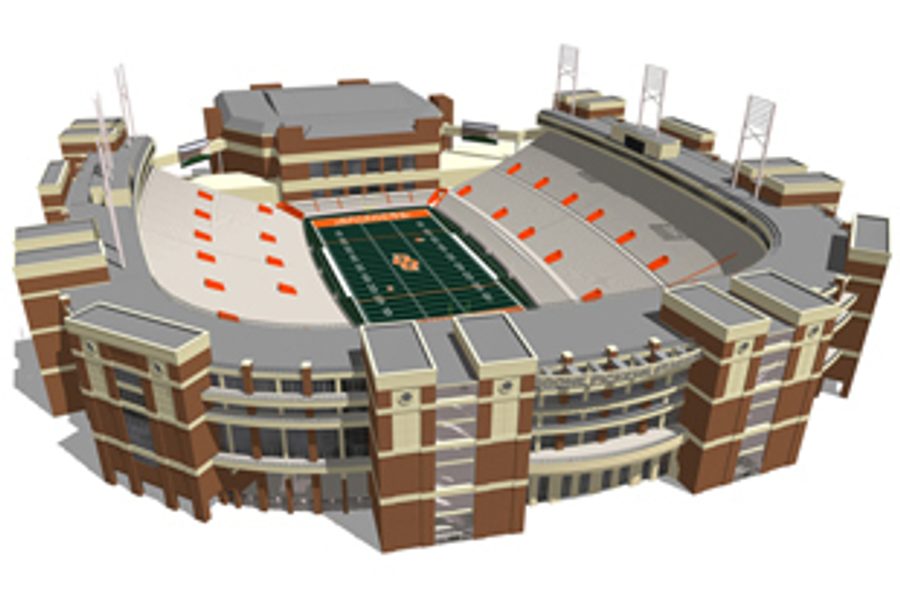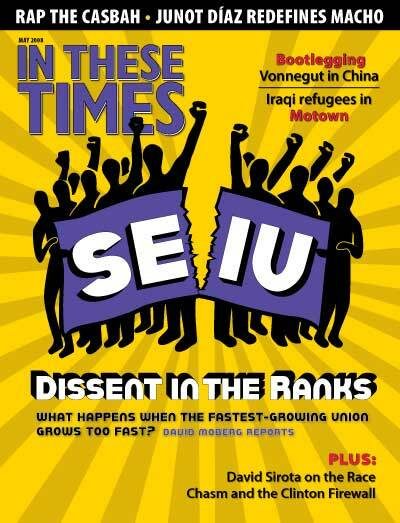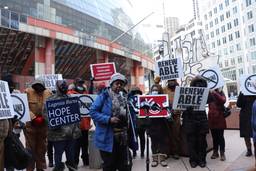
T Boone Pickens, once known as a corporate raider, is now a billionaire hedge fund investor – and one of the funders of the Swift Boat Veterans for Truth campaign that attacked Sen. John Kerry (D-Mass.) in 2004. Currently, Pickens is trying to build a reputation as a philanthropist. “I very much want to give and see the results, and not give after I’m gone,” he told The Chronicle of Philanthropy in 2006.
In 2005, Pickens, who turns 80 on May 22, donated $165 million to his alma mater, Oklahoma State University in Stillwater, Okla., to build an “athletic village” on campus. The gift is the largest donation ever to a college athletic program.
The complex, in Phase I of construction, sits north of Boone Pickens Stadium – a football complex – and east of the geology department, also named after Pickens, who graduated from the school in 1951 with a degree in geology.
The sprawling athletic complex – estimated cost, $316 million – will house indoor and outdoor practice facilities and a baseball stadium – for use only by the university’s approximately 400 athletes.
Using Pickens’ money, OSU bought hundreds of buildings in the area, in one case invoking eminent domain. That house, owned by two brothers, was bulldozed in November 2007. The university also reportedly used the threat of eminent domain to raze other homes and uproot families, some of whom had lived in the neighborhood for decades.
Under the Supreme Court’s 2005 Kelo v. City of New London ruling, eminent domain laws allow government agencies to take property from unwilling sellers on behalf of private developers – including universities – if such land is viewed as promoting the public interest.
A longtime Stillwater resident who did not wish to be identified because of possible business reprisals, says he owned property in the area, which he eventually sold to the university. “They [OSU] took advantage of a number of old ladies and old men that lived there,” he says. “Many of them didn’t want to move. They had to go buy a higher-priced house. And higher insurance, higher taxes, higher maintenance. It created a hardship on a number of older people.”
“There have been a lot of mad people,” he says, “a lot of jokes [about how] we were going to change the name of the town to Booneville.”
OSU now appears to be on the hunt for more property.
On March 13, Gary Clark, vice president for university relations, met with several church leaders of First Christian Church (FCC) to discuss OSU’s interest in the church’s land, which sits on the south end of the athletic village.
The church purchased the property in the ’50s for $40,000. The Payne County Assessor’s Office today values the property at $600,000. And it is insured for more than $1 million, says Leola Thiemann, the church’s administrative secretary.
In a March 18 newsletter to the 850-member congregation, the church’s Trustees Chair Ron Elliott wrote that, “At this time, there does not appear to be any potential for a mutually beneficial agreement between OSU and FCC, and no further discussions are planned.”
“For us to relocate, to reestablish this building with the kind of space we have,” says the FCC’s Rev. Rick Hendricks, “would take several million dollars, and that’s not even feasible for the university to consider.”
OSU has also met with Saint John Catholic University Parish and Catholic Student Center – another church in the area – to explore buying its property, as well.
A dollar amount has not been discussed, says Rev. Stuart Crevcoure, the pastor at Saint John, who adds that there has been “no real pressure to make a hasty deal, or the university sort of leaning on us to settle up with them.”
“They would be able to have a freer hand in developing this area right by the athletic facilities,” Crevcoure says, “but they would also need to guarantee that we would be able to continue our campus ministry [and] have the ability to rebuild our parish facilities in an area that is close enough that is still easily accessible, especially for the student community.” He says the 43-year-old church has about 1,200 members, 450 of whom are students.
OSU has not approached either church with the threat of eminent domain.
In 2000, Congress passed the Religious Land Use and Institutionalized Persons Act, which protects individuals, houses of worship and other religious institutions from discrimination in zoning and landmarking laws, making the use of eminent domain against a religious institution tough, though not impossible.
Says Crevcoure: “It’s very difficult to take the land of one organization that benefits the common good within the community and to replace it by saying, ‘Well, we need this for something else that’s going to be good for the community.’ “
FCC’s Hendricks puts it this way: “To move against a church like that would be political suicide.”

I hope you found this article important. Before you leave, I want to ask you to consider supporting our work with a donation. In These Times needs readers like you to help sustain our mission. We don’t depend on—or want—corporate advertising or deep-pocketed billionaires to fund our journalism. We’re supported by you, the reader, so we can focus on covering the issues that matter most to the progressive movement without fear or compromise.
Our work isn’t hidden behind a paywall because of people like you who support our journalism. We want to keep it that way. If you value the work we do and the movements we cover, please consider donating to In These Times.







